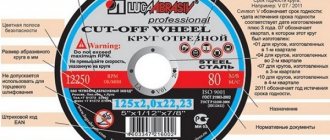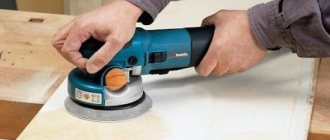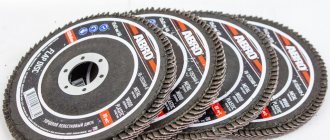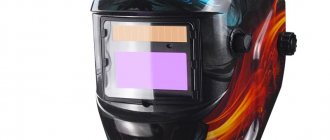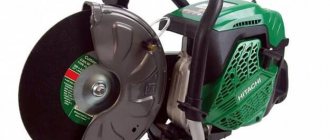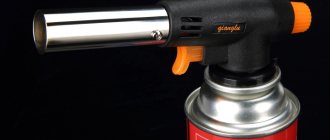Typical disk sizes for angle grinders
All interchangeable wheels have standardized sizes, so for any model of grinder you can choose a suitable size disk, even if it is “non-original” (from another company). The table below shows the typical dimensions of cutting discs in terms of thickness, diameter of the circle and seat:
| Circle diameter, mm | Thickness, mm | Mounting socket, mm |
| 115 | 1,0; 1,6; 2,0; 2,5; 3,0; 3,2 | 22,00; 22,23 |
| 125 | 0,8; 1,0; 1,25; 1,6; 2,0; 2,5; 3,0; 3,2 | 13,20; 22,23 |
| 150 | 0,8; 1,0; 1,25; 1,6; 2,0; 2,5; 3,0; 3,2 | 13,20; 22,23 |
| 180 | 1,0; 1,25; 1,6; 2,0; 2,5; 3,0; 3,2; 4,0 | 22,23; 32,00 |
| 230 | 1,6; 2,0; 2,5; 3,0; 3,2; 4,0 | 22,23; 32,00 |
The larger the diameter of the circle and its thickness, the thicker the products it can cut. Please note that the diameter of the disc should not exceed the permissible size for a particular grinder model. Thus, a 230 mm disc cannot be placed on an angle grinder with a maximum allowable wheel size of 125 mm. Such actions will force you to remove the protection, which is a violation of safety regulations, and will lead to an increase in the linear speed of the cutting edge, which is why the disk can simply fly apart during operation and injure the operator.
The diameter of the seat in most grinders is 22.23 mm, 13.20 mm is less common, and the diameter of 32.00 is relevant only for large disks. Pay attention also to the linear speed of rotation of the disk. For example, if the disc’s marking indicates a speed of 13,000 rpm, this means that your grinder must also produce such revolutions in order to work with it.
You can understand what material the nozzle can work with and what its typical dimensions are by looking at its markings on the front side. If you came to the store and picked up the disc, you can see the following:
We would like to note that sometimes the buyer may encounter non-standard nozzle sizes, and this may apply to both diameter and thickness. This often happens when purchasing “no-name” disks of unknown manufacture. We still recommend buying branded discs, since unknown ones are erased faster, and in the end you have to pay more.
TOP 5 best diamond blades for grinders
A selection of the best diamond blades based on customer reviews and ratings.
Makita D-50980, 125 mm 1 pc.
For small volumes of work, the D-50980 disk is well suited. Will cope with concrete, slate, brickwork and other similar materials.
Installs on a standard angle grinder.
The model was manufactured using high-tech equipment and meets all modern quality standards.
Dry cutting: you can work with or without coolant if necessary (but the first option is preferable - the equipment will last much longer).
Type - segmented with narrow U-shaped grooves.
Not only the composition, but also the slots in the form of keyholes give versatility: they allow air to pass through well.
Specifications:
- type: segmented;
- bore diameter: 22.23 mm;
- highest number of revolutions: 12250 rpm;
- thickness: 2 mm.
Advantages
- behaves well with reinforced concrete;
- suitable for wall chaser;
- inexpensive;
- long service life;
- does not require mandatory water.
Flaws
- exception - abrasive materials;
- Chips appear on ceramic tiles.
BOSCH Standard for Ceramic 2608602202, 125 mm 1 pc.
One of the striking examples of German quality is the Standard for Ceramic 2608602202 diamond disc from the giant BOSCH.
Designed for dry cutting with brick, marble, porcelain stoneware and all types of ceramic tiles, i.e. where there is a high risk of chipping.
It is a solid circle, the diamond cutting edge of which is continuous.
Due to this, there are no chips left even on the most capricious material.
Uninterrupted water cooling is required. Since there is no silicon carbide in the diamond blade, it is safe to work with: the risk of silicosis or lung cancer is reduced to zero.
Specifications:
- bore diameter: 22.23 mm;
- thickness: 1.6 mm;
- maximum number of revolutions: 12250 in 1 minute;
- gross weight: 0.15 kg.
Advantages
- smooth saw;
- the glaze on the tile does not chip;
- ideal price/quality ratio;
- increased wear resistance;
- good cutting depth.
Flaws
- works slowly;
- rather weak for porcelain tiles.
Metabo Promotion 624307000, 125 mm 1 pc.
The diamond blade should be selected based on the materials you will be working with. Promotion 624307000 from Metabo is a universal option for standard angle grinders.
Suitable for working with the following materials: calcareous tuff, adobe, hard sandstone, wet and regular concrete.
Disk type - segmented, i.e. it has a segmented diamond cutting edge, divided into equal-sized slots (they cool the tool during operation.
Thanks to this design, the disk can be restored for repeated use. Can be used for both dry and wet cutting.
Cost-effective to use, which means high wear resistance and long service life. The highest speed is 12200 per minute.
Specifications:
- maximum operating speed - 80 m/s;
- diameter: 125 mm;
- number of segments: 9 pcs.;
- bore diameter: 22.2 mm;
- thickness: 2.15 mm.
- diamond layer height: 7 mm.
Advantages
- heat resistant;
- high resistance;
- high performance;
- good speed;
- lasting.
Flaws
- the price tag is above average;
- may tear the edge of the material.
Di-Star 1A1R Esthete 11115421010, 125 mm 1 pc.
At first glance, it seems that finding a disk that would be ideal for dry assembly is very difficult. Disc Di-Star 1A1R Esthete 11115421010 is exactly the optimal option you need for finishing and repair work.
So whether to use coolant or not is up to you. Designed for angle grinders.
You can easily obtain a neat and precise cut when processing both ceramic tiles with decorative coating and stone.
The height of the diamond layer is 8 mm, the thickness of the disc is 1.1 mm, the body is reinforced with flanges.
Specifications:
- Diamond blade type: solid
- bore diameter: 22.23 mm
- maximum speed: 12250 rpm.
Advantages
- no chips;
- cutting speed is good;
- durability;
- thin high-quality cut;
- price.
Flaws
- when cutting frost-resistant porcelain stoneware, the disc bends;
- not on abrasive materials;
- accuracy in work is required.
Makita B-28058, 125 mm 1 pc.
This disc can be successfully used for working on brick, asphalt, concrete and marble.
The kit includes an adapter ring: it can be used with a tool with a mounting hole diameter of at least 20 mm.
Type of cut - dry: the use of liquid is not required, nor is the involvement of a second master in the process (but you should remember the high degree of dust, which requires the use of a vacuum cleaner, and the lower quality of the work).
Diamond blade type: turbo. An excellent solution for grooves and slate. Country of origin: China.
Specifications:
- disc diameter: 125 mm;
- bore diameter: 22.23 mm;
- maximum speed: 12250 rpm
- weight: 500 g.
Advantages
- price/quality ratio is at the proper level;
- cuts well;
- takes a long time to wash;
- light weight;
- easy to replace with a similar one.
Flaws
- increased noise level;
- Vibrations are felt during the process.
Cutting discs
Cutting discs are most often used when working with an angle grinder. The following nozzles are distinguished by purpose:
- For metal. Such cutting wheels are made from electrocorundum or crystalline corundum. In this case, a bakelite bond is often used inside the product. Depending on the thickness and size, the disc can cut metal profiles, stainless steel, heating pipes, etc. GRAFF GADM 115 10 is one of the representatives of inexpensive metal discs.
- For stone and concrete. Circles for cutting stone and concrete are made of silicon carbide. Please note that the disc is intended for relatively “soft” materials, such as white brick and slate (harder ones will require a diamond wheel).
- For ceramic tiles and concrete. This attachment is designed for cutting paving stones, ceramic tiles, red bricks, cutting strips for gating, etc. The disc itself is made of metal with diamond chips applied to the cutting edge. There are solid all-metal and segmented discs. The first ones are intended for wet cutting (cooling with water), as they become very hot during the process. Segmented ones are convenient for dry cutting, and they are the most popular among diamond blades. Here, for example, is a high-quality, durable segmented disk Makita B-28086 for cutting concrete and stone products.
- For wood . Discs for processing wooden structures are made of tungsten carbide or metal with abrasive coating. The first ones are designed for cutting hard and soft wood, plasterboard, gas silicate and MDF. The second one can also cut metal and even wood with nails (but this needs to be checked experimentally). Bison Professional 36859-125 is just such a representative of the “nail saw”.
- Universal. These attachments can cut almost all types of materials (for wood, it is better to take a direct-use attachment). In particular, they are convenient to use when you have to cut different materials in one working day, and you don’t want to waste time changing the nozzle. Universal models even cut reinforced concrete. However, they are often quite expensive, and sometimes it is more profitable to buy two disks for different types of materials being processed. Of the good universal circles, we can recommend Wolverine 100125, which is suitable for both wet and dry cutting.
TOP 3 best petal discs
Review of the best petal discs for an angle grinder.
Hammer petal disc 213-017
Flap disc from a German power tool manufacturer: small but capable of serving you for a long time.
If you have to work with plastic or wooden products of any density, or with metal structures, we recommend purchasing this particular product from Hammer.
Firstly, it grinds surfaces perfectly, secondly, it has a long working life, and thirdly, it does not overheat during operation due to optimal heat dissipation during the entire process.
There are no harmful impurities in the product (and this is often the case with other well-known manufacturers), so interaction with it will not harm your health.
Suitable for both permanent and one-time jobs. Great for cleaning inside corners. There are 2 pieces in the package.
Specifications:
- grit (P): 60;
- landing diameter: 22 mm;
- diameter: 125 mm.
Advantages
- wear-resistant;
- affordable price;
- always on sale;
- good level of grain;
- There is a replacement included.
Flaws
- the abrasive on the wheel quickly crumbles;
- does not last long on a straight seam;
- a limited number of materials are allowed for processing.
Petal disc Vira 559125
The flap type grinding wheel is suitable for both primary and final machining.
Shows excellent performance when processing wooden and metal surfaces.
You can easily prepare the floor in your house for painting, or reconstruct the front part of a wooden house.
The petals are arranged radially in a fan-like manner, due to which the performance of this element is high (in comparison with similar consumables).
The internal (landing) diameter of the disk is 22.2 mm, the external one is 125 mm, the modification is flat. The nominal number of discs in a set is 1 piece.
Country of origin: China.
Specifications:
- grit: P25;
- purpose of the circle: wood, metal, plastic;
- maximum speed: 12000 per minute.
Advantages
- minimal vibration;
- good equipment productivity;
- affordable price;
- sparks and parts do not fly away;
- cleaning of welds.
Flaws
- Suitable for angle grinders only;
- no spare;
- quickly depletes its resource.
Hammer petal disc 213-016
An element for treating metal workpieces and surfaces from paint and corrosive deposits, processing welding seams, destroying burrs on metal, preparing a wooden product for treatment with paints and varnishes, etc.
It is used both manually and on a machine (other grinding device), for simple and complex configurations (edges and joints of parts).
Externally, Hammer 213-016 is similar to a standard grinding wheel, but there is an important nuance: the sandpaper is arranged in petals along the diameter.
The petal circle “sits” tightly in the cartridge.
The sandpaper is attached with resin. The package is sold in 2 pieces (main and spare). The depth of the recess can be varied.
Specifications:
- grit (P): 40;
- landing diameter: 22 mm;
- diameter: 125 mm.
Advantages
- high quality abrasive processing of parts;
- petals are used evenly;
- decent level of grain;
- compact;
- cheap.
Flaws
- you need to use safety glasses while working;
- it is necessary to choose the right type of device;
- Some brushes spark during operation.
Roughing
It’s worth mentioning right away that roughing and grinding discs go hand in hand, and in many stores in the “type” parameter of the attachment it may be written: “roughing grinding disc.” In our article we will divide this “couple” into two types. Peelers in this context are an attachment for freeing the structure being processed from the outer layer, for example, from rust. There are the following peeling attachments:
- Cord brushes. Cord brushes are disc or cup-shaped. Disc ones are convenient for cleaning vertical structures, for example, a tubular fence, and cup-shaped ones are used for cleaning horizontal surfaces. So cord brushes are very convenient for cleaning a car body after welding or removing rust. Here is an average-priced brass cord brush STAYER 35125-150:
- Roughing discs. Sanding discs, like cord brushes, can be flat or cup-shaped. They are intended for cleaning welds and preparing metal surfaces for grinding.
Dry cutting
For the dry method, discs are used in which air passing between the segments is used to cool the tool. The technology should ensure dust removal, which increases productivity and facilitates work. However, such cooling is not enough, so it is necessary to take breaks to cool the diamond wheel.
The dry method is used when performing work in rooms with laid communications, in cases where the use of water is impossible. Discs designed for dry cutting can also be used for wet cutting, but not vice versa.
Grinding
Grinding wheels are used for polishing concrete, metal and wooden surfaces for painting or priming. Attachments for circles can be made of sandpaper, felt and even felt. In turn, the design of sanding wheels can be petal or flat (put on a wheel).
Each grinding disc has its own grit size. It is selected depending on the work being performed. Below is a table for selecting wheel grit depending on the type of grinding:
| Types of grinding | Recommended grit number |
| Flat | 16 — 36 |
| Round roughing | 24 — 36 |
| Round finishing | 60 — 100 |
| Finishing a multi-blade tool | 170 — 220 |
| Finishing | 180 — 320 |
| Thread grinding | 100 — 280 |
Features of application
After purchasing diamond or other discs for an angle grinder, it is important to familiarize yourself with the list of materials for which they are intended. In order not to forget what materials they are intended for, it is recommended to save the packaging until the products are disposed of.
It is necessary to install the product into the tool using a special fixing key. If, after installing the wheel in the seat of the angle grinder, it begins to rub against the cover, then it is prohibited to start the device. Various types of work with angle grinders should be carried out using protective equipment: goggles, a respirator or mask, gloves and special clothing.
It is important to pay attention! When working with an angle grinder, the tool should be held with both hands, as strong vibrations occur during its operation.
When cutting granite or concrete, it is recommended to use the wet method. This will not only eliminate the occurrence of dust, but will also allow the cutting disc to cool during operation. Both methods can be used to cut stone, marble or ceramics.
To summarize: how to choose a disc for an angle grinder?
To properly buy a disc for an angle grinder, you need to:
- Know the maximum size of disks that your angle grinder can handle. You cannot take disks larger than the device allows.
- Know the maximum speed of the grinder . The higher the rotation speed of the angle grinder, the smaller the disk size it can work with.
- Processed material . There are discs for wood, metal and stone. There are universal ones that can cut almost anything.
- Socket size . The size of the wheel seat must correspond to the same parameter in the angle grinder.
- Manufacturer . Do not buy frankly cheap discs or unknown products like hot cakes in the school cafeteria, and the savings will be minimal.
Tips on how to extend service life
What type of diamond blades do you work with most often?
SolidSegmented
There are a few simple tips to ensure that a newly purchased cutting wheel lasts as long as possible and works out the entire amount spent on it:
- Discs with a larger wheel diameter will work longer because they have a low load on the cutting crystals (but remember that the size of the wheel must be selected according to the type of mechanism!).
- The more powerful the tool, the more stable its speed, thus the disc wears out less.
- Choosing the right disc type for the material.
- Never exceed the permissible speed.
Diameter, fit, quality
Now you know the pros and cons of each type of circle, the hardest part of choosing is over. It remains to find out only two simple parameters: the size of the disk and the desired quality category.
For the grinder, circles with an internal hole of 22.5 mm are suitable. Other types of planting are used only in special equipment (saws, machines, tile cutters). The diameter of the disc depends on the type of machine: 115 and 125 mm - for small ones, 150 and 180 - for medium size and power, 230 mm - for high power.
Diamond blades vary in quality. The higher it is (and the higher the price), the longer you can work without replacing the wheel. For those who regularly cut concrete, it is more profitable to buy high-quality components, because constant replacement is more expensive. But if you only need to make a few cuts, there is no point in buying an expensive professional disc: domestically produced wheels will do.
Scope and properties of diamond segment disc
Diamond segmental blades are used when cutting high-strength materials, these include: concrete, masonry, bricks. They are used only for dry cutting. Thanks to the segmented shape, cooling and removal of dust remaining after cutting is carried out. The more segments there are on the disk, the faster it will cut the material. While conventional discs fail very quickly, diamond ones do not lose cutting depth and maintain the diameter of the disc, due to this they justify their high cost. And if used correctly, they can even help you save money.
Reasons for decreased cutting quality
There are times when a diamond disc stops cutting the material; in order to return it to working form, it is recommended to cut off the abrasive layer until diamonds appear. Also in such cases, it is worth paying attention to the correspondence of the disc markings to the material being cut. The service life of a diamond blade largely depends on what materials it will cut. Accordingly, with low-density materials, the disc wears out less than when cutting high-grade concrete. Long periods of continuous operation and overheating can lead to a crack in the disk, and subsequently to its failure.
Let's cut!
Here are some typical situations in which you might encounter problems cutting concrete:
- Pouring the foundation. Sometimes calculations are inaccurate, or unexpected adjustments are made to the plan. But the foundation has already been poured and has had time to harden. How to adjust it to new sizes?
- Redevelopment of a city apartment. You decide to expand or move the doorway. How to make a neat hole of the required diameter in a reinforced concrete wall?
- Redevelopment of a retail or exhibition hall. Is it possible to cut off part of the wall without damaging the rest?
- Dismantling of structures. Some elements must be dismantled carefully if there is a risk of damage to nearby objects.
All these problems are now successfully solved by diamond cutting. This is cutting concrete or reinforced concrete using discs with a special coating - made of artificial diamond. The tool that can be used for such work ranges from a regular “grinder” (also known as an angle grinder) to more specialized and expensive saws or concrete cutters. The choice of tool depends on the desired cutting depth. A grinder can cut through concrete no more than 80-100 mm, but for everyday tasks this is enough.
We have decided on the tool. But it is equally important to choose the right type of disk.
